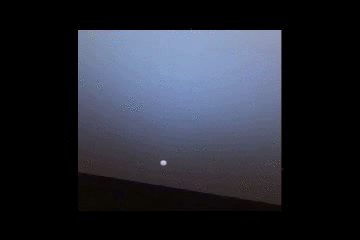- Original Caption Released with Image:
-
On Sol 20 of its journey, Mars Exploration Rover Opportunity woke up around 5:30 in the martian afternoon to watch the sunset. A series of five sets of three-color images from the rover's panoramic camera was acquired looking toward the southwest. Each set used an infrared, green and violet filter, rather than the human red-green-blue, so that the maximum panoramic camera wavelength range could be covered by the observations, enhancing the scientific value of the measurements.
A color image was made from the first post-sunset sequence of calibrated color images, with the color balance set to approximate what the sunset color would have looked like to the human eye. The color seen in this first post-sunset image was then used to colorize each image in the sequence. Approximately one-minute gaps between consecutive color images meant the Sun's position changed within each color set, so the images had to be manually shifted to compensate for this motion. In this fashion, the position and brightness of the Sun are taken from each individual image, but the color is taken from a single set of images. The images were then combined into a movie where one color set fades gracefully into the next. Analysis of the five color sets shows that there were only small color variations during the sunset, so most of the real variations are captured in the movie. The rapid dimming of the Sun near the horizon is due to the dust in the sky. There is nearly twice as much dust as there was when the Mars Pathfinder spacecraft, which landed on Mars in 1997, imaged the sunset. This causes the Sun to be many times fainter. The sky above the Sun has the same blue tint observed by Pathfinder and also by Viking, which landed on Mars in 1976. This is because dust in the martian atmosphere scatters blue light forward toward the observer much more efficiently than it scatters red light forward. Therefore, a "halo" of blueish sky color is always observed close to the Sun. We're only seeing half of this halo in the movie, because the other half is below the horizon.
- Image Credit:
-
NASA/JPL/Texas A&M/Cornell
Image Addition Date: -
2004-02-26
|

 Planetary Data System
Planetary Data System












